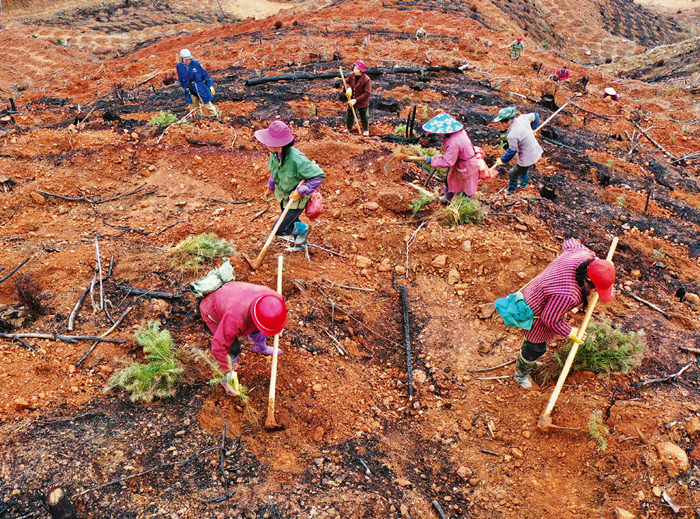|
||||||||||
| Home Nation World Business Opinion Lifestyle ChinAfrica Multimedia Columnists Documents Special Reports |
|
||||||||||
| Home Nation World Business Opinion Lifestyle ChinAfrica Multimedia Columnists Documents Special Reports |
| ChinAfrica |
| Flourishing Green Shields |
| China is expanding forest carbon sinks as part of efforts to mitigate climate change |
| By GE LIJUN 丨VOL. 14 MARCH 2022 ·2022-03-16 |

Farmers plant saplings in Xikeng Village, Ji’an City, Jiangxi Province, February 13 (VCG)
Reservoirs capable of capturing and storing carbon dioxide are known as carbon sinks. Forests are one of the largest carbon sinks on the planet, and have a critical role in the fight against global warming.
As China aims to become carbon neutral by 2060, expanding forest carbon sink has become a major priority for the country. According to data from the National Forestry and Grassland Administration, China is able to offset 14.1 percent of its fossil fuel carbon emissions with an average yearly carbon sequestration of 201 million tons in its terrestrial ecosystems, with forests accounting for around 80 percent of that.
According to the Ministry of Natural Resources, forest cover now constitutes 23.04 percent of China’s land area, up from 12.98 percent in the 1980s, and is the world’s fastest growing. “This figure will be increased to 28-29 percent,” Zhu Jianhua, an associate researcher with the Chinese Academy of Forestry, told People’s Daily.
Reforestation and forest management are progressively ensuring the economic and environmental viability of forests while increasing their carbon sequestration. It is therefore necessary to recognize the multifunctional values of the forest, in all dimensions: economic, ecological and societal.
Multiple benefits
Forestry carbon sequestration programs in China date back to 2001. These were mostly Clean Development Mechanism initiatives up to 2011. Since 2011, the nation has been developing regional carbon markets modeled after the European carbon market. On July 16, 2021, the national carbon market was established, ushering in a new era of carbon transactions, with the initial focus on the energy industry.
A carbon market is designed to cut emissions by offering rewards and punishments in the form of credits, allowances, or quotas that can be bought and sold. In a carbon market, companies are allotted credits for emitting less pollution than they are allowed, which can be purchased by those who exceed their quota or limit of emission.
Despite ongoing development, forestry projects continue to play a minor role in carbon markets, accounting for only 0.74 percent of carbon market transactions. At the moment, the Chinese carbon market is dominated by voluntary Verified Carbon Standards (VCS) projects. The VCS is a carbon crediting mechanism through which credits are issued to projects that reduce or remove greenhouse gas emissions. As of June 2021, the number of forest carbon sink projects under the VCS standard stood at 28 in China, which was expected to soak up annual emissions of 9.49 million tons, according to a report by the Forward Industry Research Institute.
With its vast expanse of forests, which cover 81.7 percent of land, Lishui in east China’s Zhejiang Province is well positioned to take the lead in strategic forestry planning for climate change mitigation. The city announced on December 22, 2021 the establishment of a forest carbon sink management administration to explore and realize the economic value of forest products, currently the first city-level administrative body of its kind in China.
The town of Xianliang in Lishui has benefited from the carbon credit transactions. In November 2021, a provincial-level conference was held there. At 100 yuan ($15.78) per ton, the organizer purchased the town’s carbon credits to offset 22.72 tons of carbon generated by the conference. Based on forestry projects covering an area of 1,121.13 hectares, the town is able to reduce an average of 5,166.68 tons of carbon dioxide equivalent per year, which has huge revenue potential for those engaged in forestry.
The carbon offset project is beneficial to all parties concerned. The Huangshui reforestation project in Xining, Qinghai Province, spans 38,933 hectares and was set up with the government support of roughly 900 million yuan ($142 million). During the project’s 100-year lifespan, carbon sequestration is expected to generate 1.08 billion yuan ($170 million).
Local forest cover grew from 30 percent in 2015 to 36 percent by 2020 as a result of the project’s execution. In addition, 35,000 jobs were generated as a result of the initiative. According to Yi Lubei, Deputy Director of the Qinghai Forest Carbon Sink Service Center, the first phase of the project has achieved a total of 254,600 tons of carbon credit, which was delivered to Shell Energy (China) in May 2020.

Forests in Nanjianyan scenic zone, Lishui City, Zhejiang Province (VCG)
Role of enterprises
Companies have shown great interest in carbon sinks and new business models have been developed.
Oil and gas companies may also participate in carbon sink initiatives to offset their own emissions. On November 11, 2020, the first carbon-neutral forest constructed by China National Petroleum Corp. was officially open in Maanshan in Anhui Province, to offset emissions from the Daqing oil field in Heilongjiang Province.
The maturity of the digital technology, as well as the availability of an actual commercial opportunity, is incentivizing private enterprises to enter this industry. Ant Forest is a carbon footprint tracking application developed by Alibaba Group. The application encourages users to reduce their greenhouse gas emissions by planting trees in regions where the ecosystem is in danger. As of August 2021, Ant Forest has mobilized 613 million people to plant trees, cutting a total of more than 20 million tons of carbon emission, the equivalent of that from using up to 4,000 billion sheets of A4 paper.
According to Chen Shaozhi, an expert in forest economics at the Chinese Academy of Forestry, the development of forest carbon sinks is gaining momentum. To achieve zero net emissions, there is an urgent need to strengthen policies and technical methods. This will help contain the risks faced by the various actors involved.
The sector has seen a flurry of promotional and regulatory activities, culminating in the implementation of a national directive on forest carbon sinks on December 31, 2021. This is China’s first national standard for forest carbon sinks, with the goal of guiding third-party organizations that assess and certify forest carbon sink projects so that forest carbon credits entering the Chinese voluntary market are genuine and legitimate. Forests will likely play a bigger role in attempts to mitigate global warming as a result of these new initiatives.
|
||||||||||||
| About Us | Contact Us | Advertise with Us | Subscribe |
| Copyright Beijing Review All rights reserved 京ICP备08005356号-5 京公网安备110102005860号 |